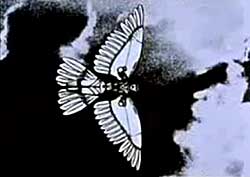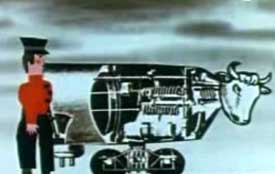 With a musically intriguing & occasionally experimental soundtrack by Wrodzimierez Kotonski, Labyrinth (Labarint, 1963) is almost as fascinating to hear as to observe.
With a musically intriguing & occasionally experimental soundtrack by Wrodzimierez Kotonski, Labyrinth (Labarint, 1963) is almost as fascinating to hear as to observe.
Aesthetic animation begins with a scene of the cloudy sky, & a bird flitting realistically in gliding, dropping circles. It's a riveting image that immediately informs the viewer this is no ordinary cartoon, but a true work of pictorial art.
The "bird" drops & swoops into closer view, revealing itself actually to be a man wearing a winged contraption that permits him to fly bird-like. And now we know we're in a world of startling fantasy.
 Into a world inspired by Max Ernst's woodcut collages the gliding man swoops. Into a world inspired by Max Ernst's woodcut collages the gliding man swoops.
Through windows of the old city we see strangeness & beauty & ugliness. A dinosaur skeleton walks the street. A giant insect walks the ledge of a building.
Our glider-man has discarded his wings & walks about the city, enters a building to escape the stalking, braying dinosaur skeleton.
He slays a fearful crocodile-headed monster, then plucks a rose & attempts to court a Victorian maiden who rebuffs him. She kisses the slain monster, reviving it, feeds the monster the healing rose, & leaves with it as her lover.
Similarly bizarre incidents unfold one after another, featuring animal-headed people & human-headed animals, all things potentially predatory.
 A walrus in tophat mugs a man-bird for his wings, then climbs atop a building & leaps to his death testing wings too small to sustain him. A walrus in tophat mugs a man-bird for his wings, then climbs atop a building & leaps to his death testing wings too small to sustain him.
A series of events unfold like acts on a burlesque stage, each prettier & stranger than the last. Then our hero enters a bizarre cathedral wherein he falls prey to a horrific scientist's demented experiments.
A weird black bird saves him from his predicament & he flees the cathedral, pursued by the scientist, whose partially robotic components permit him to fly.
As our hero flees the labyrinthine city, he is once more wearing his attractive glider wings, but is pursued by hideous destroying bats.
Jan Lenica's influfence on Terry Gilliam would seem to be palpable, but where Gilliam makes it funny & absurd, Lenica makes it absurd & nightmarish, more Kafka to Gilliam as P. T. Barnum.
 More Polish animation done with paper cutouts & stop-motion, Janko the Musician (Nowy Janko Muzykant, 1960) shows us a soldier in red bringing a robot cow from the barn, winding it up, & marching with it through town.
More Polish animation done with paper cutouts & stop-motion, Janko the Musician (Nowy Janko Muzykant, 1960) shows us a soldier in red bringing a robot cow from the barn, winding it up, & marching with it through town.
Incredibly bizarre flying machines appear in the sky, & even things of nature are disturbing. The soldier in red, who may assume is Janko, plays weird music on a coronet while villagers dance & zloties rain down from heaven.
We are momentarily brought into a music hall for a piano concert, but quickly removed from this setting to follow an eerie bone-bird. We look into house after house at weird objects & people & weirder events.
 The soldier in red breaks into one of these houses, removes a piano to the countryside, tries to play it but finds that it is full of objects of all sorts. When these are removed & discarded, he is at last able to play out in the open, with serious demeanor. The soldier in red breaks into one of these houses, removes a piano to the countryside, tries to play it but finds that it is full of objects of all sorts. When these are removed & discarded, he is at last able to play out in the open, with serious demeanor.
The owner of the piano tracks him down & harangues him to no avail.
So he decides to attack Janko the thief with a pitchfork, except that an angel appears before the victim of the theft & blesses both him & the thieving soldier in red. She turns the robot cow into a winged horse, & the soldier rides away through the sky.
Strongly reminiscent of the naive art movements of Poland, Hungary, & the Balkan nations, an entire world is created scene by scene, of peasantry & ritual, until strangeness becomes familiar, & the world almost plausible.
 Wlodzimierz Kotonski has composed an electronic science fiction soundtrack for Dom (House, 1958), an avant gard animated collage of photographs & film bits & stop-motion objects, by Walerian Borowoczy & Jan Lenica.
Wlodzimierz Kotonski has composed an electronic science fiction soundtrack for Dom (House, 1958), an avant gard animated collage of photographs & film bits & stop-motion objects, by Walerian Borowoczy & Jan Lenica.
Entering the sinister old apartment house, we observe surrealistic events, such as a soldering gun used as a pistol to insert light into a floating brain that attaches itself to a machine that generates additional objects.
We encounter a young woman having a relationship with a seriously disturbing mannequin's head, foot boxer duellists, a still-life devoured by a predatory wig (a sequence reminiscent of some of the food-obsessed stop moton animation of Jan Svankmajer), a looping sequence of a man continuously removing his hat to place on a hat rack, still photos & drawings of odd families & fairy creatures.
There is no sense of continuity or build-up of story, however surreal, & it doesn't even restrict itself to events within the apartment house, since landscapes & street scenes are inserted at one point.
It's purely experimental animation for the sake of the experiment & as such less satisfying than collage films Lenica did alone, such as The Labyrinth which for all their surreality do add up to a consistent vision. Still, there are horrific events & images imbedded in Dom that make its eleven minutes of chaos more than tolerable.
copyright © by Paghat the Ratgirl
|


 Into a world inspired by Max Ernst's woodcut collages the gliding man swoops.
Into a world inspired by Max Ernst's woodcut collages the gliding man swoops. A walrus in tophat mugs a man-bird for his wings, then climbs atop a building & leaps to his death testing wings too small to sustain him.
A walrus in tophat mugs a man-bird for his wings, then climbs atop a building & leaps to his death testing wings too small to sustain him.
 The soldier in red breaks into one of these houses, removes a piano to the countryside, tries to play it but finds that it is full of objects of all sorts. When these are removed & discarded, he is at last able to play out in the open, with serious demeanor.
The soldier in red breaks into one of these houses, removes a piano to the countryside, tries to play it but finds that it is full of objects of all sorts. When these are removed & discarded, he is at last able to play out in the open, with serious demeanor.